A 10 Meter Indoor Dipole Antenna
Necessity Is the Mother of Invention
A linear-loaded 10 meter indoor dipole antenna was my solution to keep operating on HF, after being forced to live in an apartment with severe HF operating restrictions.
Page Content
Dipole Linear-loading
Indoor Dipole
Performance
The Story Behind It
As I was new to this potentially depressing type of environment, I needed a little challenge to feel alive again. My refusal to surrender brought out the experimenter in me.
Linear-Loading to the Rescue
After some thinking and measuring, I whipped up a linear-loaded 10 meter dipole, using 300 ohm TV twinlead (the heavy-duty type for outdoor usage) and strung it diagonally across the room, about five feet above the floor and three feet below the ceiling, between two opposite bookcases. I fed it with RG-8X and a BNC-to-dual-post center connector.
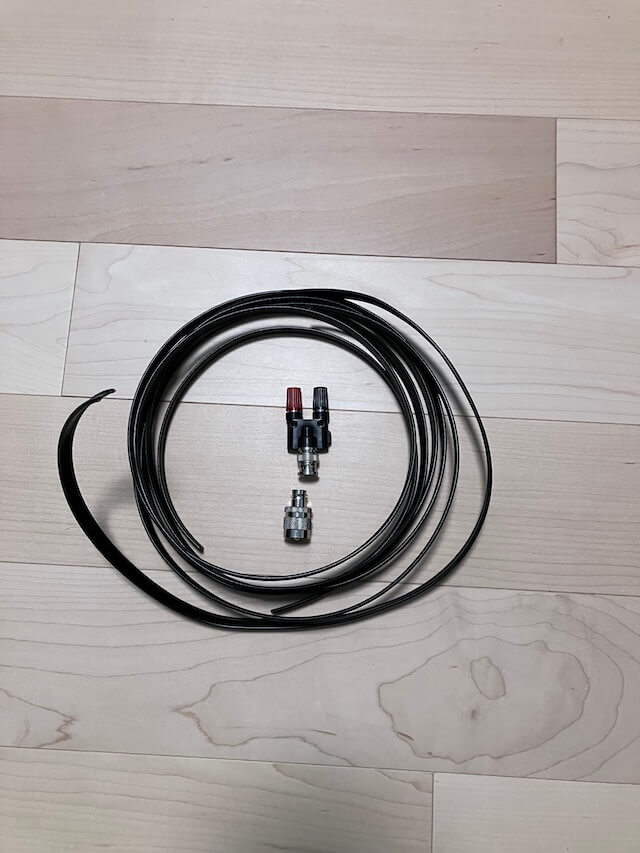 Dipole parts
Dipole parts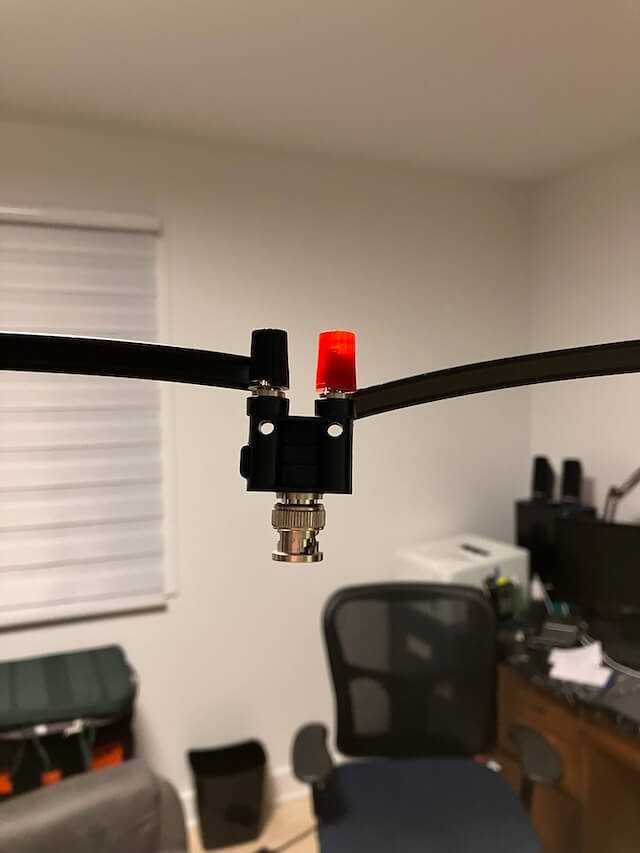 Center insulator.
Center insulator.Yes, I know. Most of you will wonder why I did not use a balun. I could expand at length on the many reasons why but, to make a long story short, a balun is meant to keep a dipole radiation pattern symmetrical when fed with an unbalanced coax.
But, hey, there is no way that an indoor dipole can possibly have a radiation pattern according to Hoyle when operated indoors, within the confines of a ground-floor apartment, with two stories of apartments above, concrete, steel and all kinds of wires in the walls!
No way!
Furthermore, my linear-loaded dipole has an impedance of 39 ohms, where it is installed, as measured with my RigExpert antenna analyser! In my book, that's close enough to my coax's impedance of 50 ohms. That turns out to be 1.28:1 SWR. Like I said: close enough.
Indoor Dipole
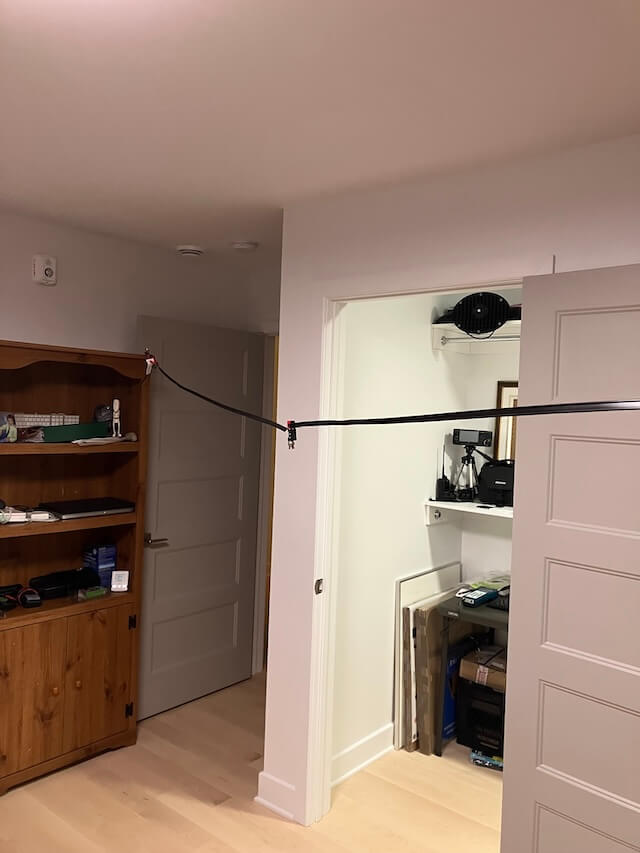 10 meter linear-loaded antenna strung indoors between bookcases
10 meter linear-loaded antenna strung indoors between bookcasesAfter some minor trimming I was getting a VSWR of 2:1 at the bottom of the ten meter band which is where I want to operate CW. I stopped trimming at an overall length of 11 feet. That's less than the 16.68 feet a normal halfwave dipole for ten meters would require. Linear-loading yields a shorter antenna for the same frequency of resonance.
I could have kept on trimming to get a VSWR closer to 1.28:1, but I was using a tuner for this experiment. So I didn't care. Again, close enough. Besides, I was becoming anxious to try it out.
Important: For more on the linear-loading technique of a dipole, and construction details, read this other page on my website.
Operating QRP within an apartment building is mandatory if you want to keep peace with your neighbors.
I sent out a CQ on 28.050 MHz using only 5 watts. Nothing happened. The band sounded dead. On the second attempt, WV4P near Memphis, Tennessee, some 1077 miles (1733 Km !) away, spotted me and reported my CQ on RBN giving me an 8dB signal-to-noise ratio!
Performance
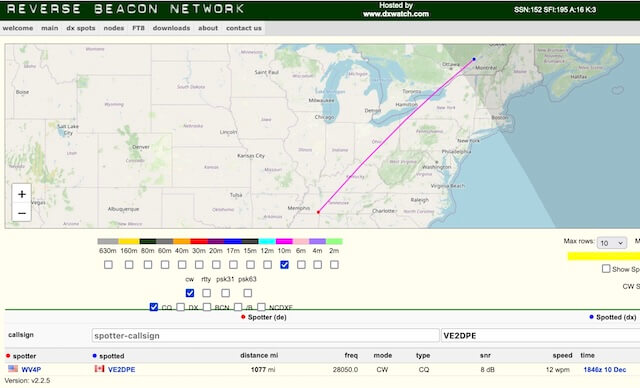
Wow! That's what I call a feat, getting this kind of result with a 10 meter indoor dipole antenna, from within a ground-floor apartment of a 12-apartment building, using just 5 watts. By the way, the A-index and K-index were 8 and 2 respectively that day. Only fair propagation conditions, at best.
I was especially proud that my little experiment with an indoor dipole antenna worked better than I had expected. Ham radio doesn't get any better than that.
Life is great again!
The Story Behind My Linear-Loaded 10 Meter Indoor Dipole Antenna Experiment
In September 2024, we moved from an ideal location for large HF wire antennas (a full size 160 meter half wave dipole was not a problem) to a two-bedroom apartment in a large building with HOA-like restrictions.
The Blissful Era
For decades, I enjoyed a very comfortable ham radio setup for HF. I experimented with many HF wire antennas before settling for an off-center-fed dipole for 80 meters and an LDG-100 ProII tuner, serving as a multi-band, 80-10M, HF antenna system.
In recent years, my shack was sporting an IC-7300 as my main rig with an IC-7200 as backup, just in case...
I had countless accessories that made my ham radio operating very enjoyable.
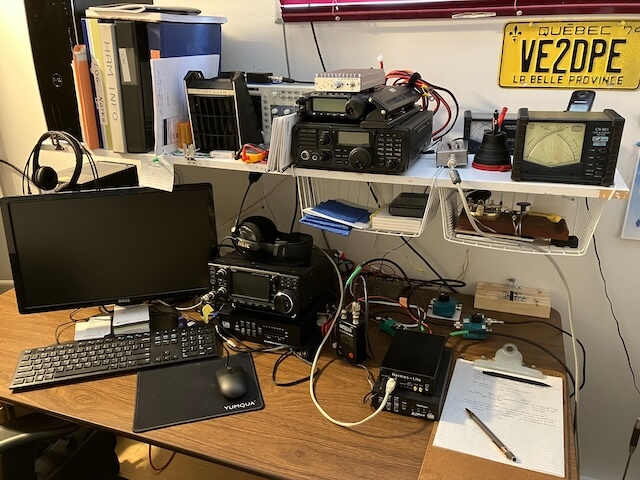 My former shack in 2023
My former shack in 2023My 10 meter indoor dipole antenna was the result of a previous successful experiment.
My favorite activity, when I was not on the air, was experimenting with wire antennas for HF. I sure had the space for it: 25 000 square feet of land with tall mature trees all around.
I would draw up plans and undertake extensive research to validate and document every unorthodox idea that would pop into my head. Then, I would gather wire, transmission cable, insulators and what not ... and proceed to test my idea.
I eventually self-published eBooks on Amateur Radio HF Wire Antennas, a list of which you will find here on my website:
Life was great.
Then the Unexpected Happened!
I lost everything. Well, to be honest, not everything. I'll tell you why in a moment.
Here is what happened.
Our house has a river flowing some 15 feet below in the back. Fifty years ago, there were some 30 to 45 feet of land and trees between the back of our house and the steep, treed slope to the river.
On July 21, 2023, in mid-afternoon, a supercell settled over our property and dumped some 140 mm of rain within a scant 20 minutes.
The river had already swollen from heavy rainfalls upstream a few hours earlier.
My wife was worriedly looking at the river which had become quite agitated. Then, the land behind our house suddenly fell away into the river, tall mature trees and all.
She yelled and I rushed to join her at the window. Rain was thundering on our roof so hard we had to shout to hear each other.
We were looking 'down' into the churning waters of the river! A major land slide had taken a huge chunk out of our back yard and formed a small island with trees, most of them standing proudly erect, in the middle of the river, which created an obstruction and further increased the erosion of what little there was left of our land behind our house.
The next day, we found out that we only had barely ten feet of unstable land separating us from the churning river waters which had now risen considerably.
Well, to make a long story short, two days later, a Civil Emergency responder and a couple of engineers from the "Ministère de la sécurité publique du Québec" came over to investigate. They declared our house in "imminent threat" of further landslides. We were told that we had to have the house torn down and relinquish the land to the municipality.
We did not lose everything. We benefited from a special emergency fund for citizens who, like us, lost their home due to a natural disaster such as floods or landslides. It did not compensate us for the real market value of our property, far from it, but it enabled us to start afresh.
Downsizing: QRP to the Rescue
We now live in a large two-bedroom apartment, which we were lucky to find, just 5 minutes walking distance from where we used to live. Its on the ground floor of a 12-apartment building, itself part of a six-building complex sited on a very well thought out property with trees and lots of open space between the buildings.
One of our two bedrooms serves as a hobby room. My wife uses half of it for her hobbies (painting, stained glass creations). I use the other half for my two hobbies: ham radio, of course, and writing/publishing, my second and companion hobby. My shack is tucked in the walk-in wardrobe of that bedroom.
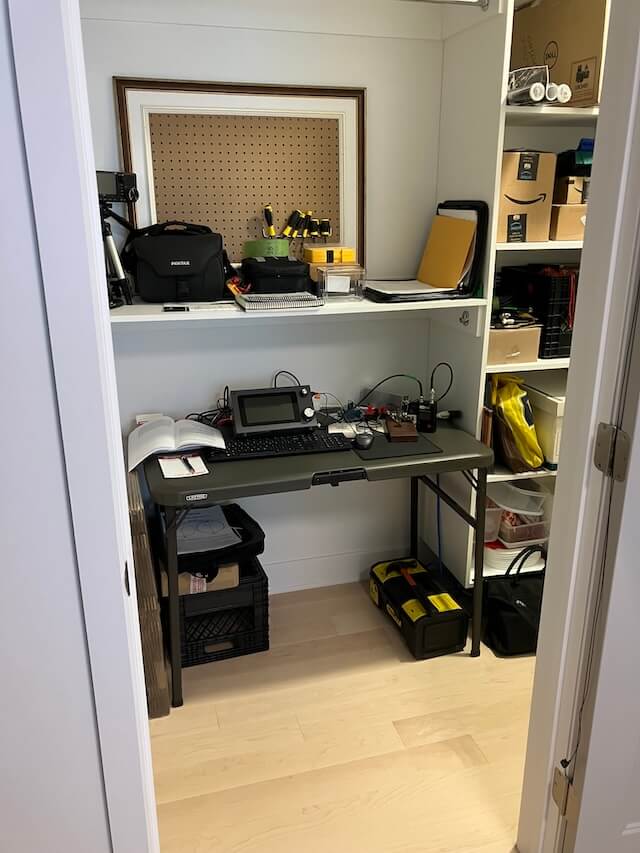 New minimal shack in walk-in wardrobe.
New minimal shack in walk-in wardrobe.Due to HOA-like restrictions I cannot have any form of outdoor antenna. Therefore, I am now in the process of taming QRP operating from within our apartment.
With my knowledge of HF wire antennas, I quickly drew up plans to try a linear-loaded 10 meter indoor dipole antenna for QRP operation. I had a hunch that it would work, not as well as a properly installed outdoor half wave dipole and 100 watts, of course, but still...
It worked!
Ham radio will constantly amaze me and reward me!
73 de VE2DPE
Claude Jollet
104-30 avenue des Berges,
Notre-Dame-des-Prairies, Québec, Canada J6E 1M9
QTH Locator: FN36gb
Disclosure
If
you make a purchase via a link on this site, I may receive a small
commission on the transaction, at no extra cost to you. Thank you!
(One word queries work best)
HF Antennas
Section
Contents
VHF/UHF Antennas
FOUND THIS
SITE
USEFUL?
VE2DPE
Is a member
in good standing
of
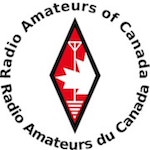

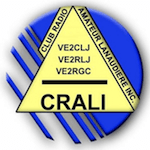
Also a proud member of an international community of solopreneurs
using SoloBuildIt!
(SBI!)
to promote my self-published eBooks
since 2005.
See my review
of this unique product for online businesses.
CQ CQ CQ
If you have a question, a comment or a topic you would like me to cover, please do not hesitate to ask here.


